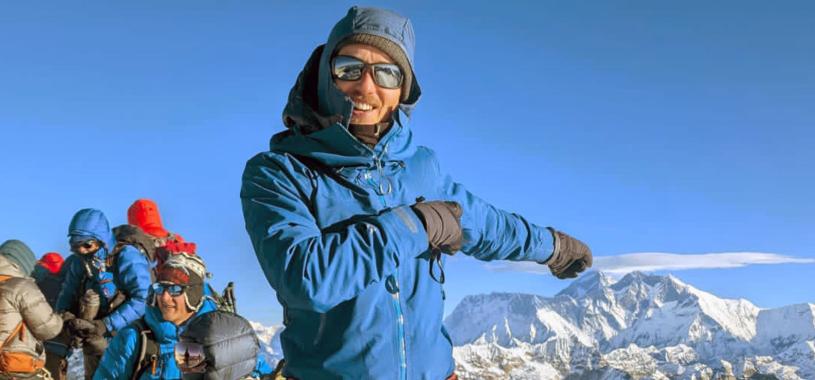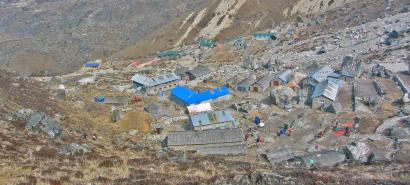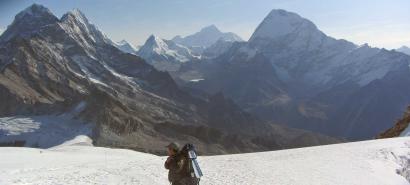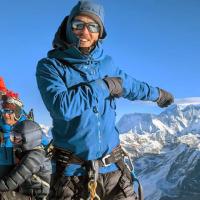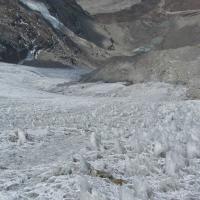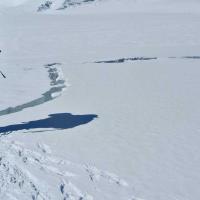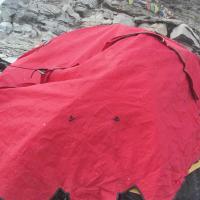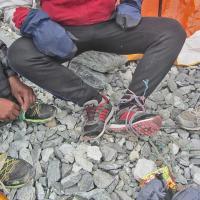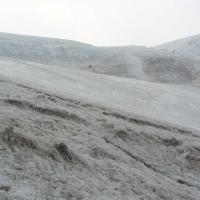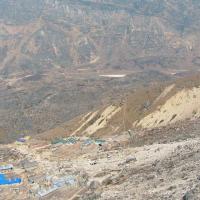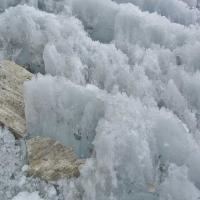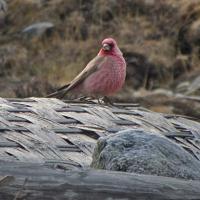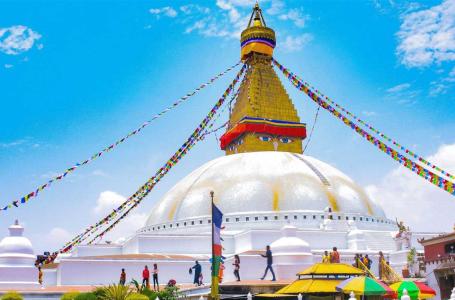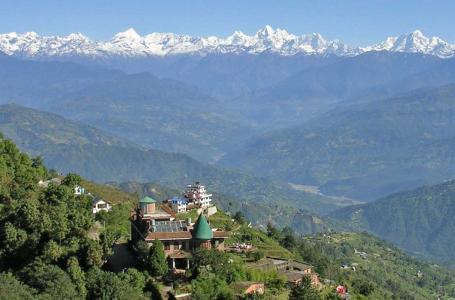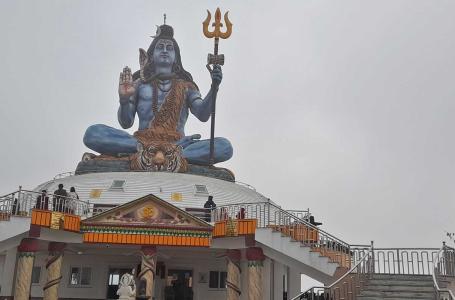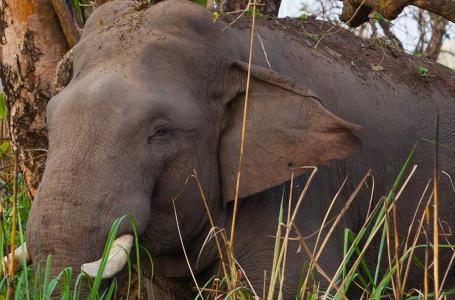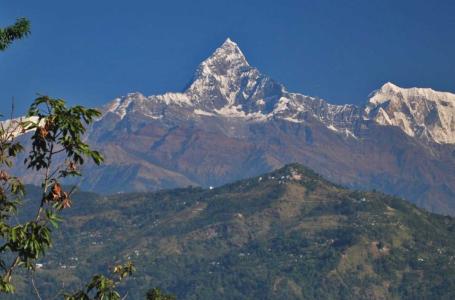- 01 Pax USD 2550 pp
- 02 to 05 Pax USD 2350 pp
- 06 to 10 Pax USD 2150 pp
Itinerary
Upon landing at Tribhuvan International Airport, you’ll be greeted by your local team and transferred to your hotel in Kathmandu. After some rest, you’ll meet your guide for a trip briefing covering the climbing route, required gear, permits, insurance checks, and safety procedures. The evening is free to relax or stroll around Thamel, Kathmandu’s bustling trekking hub.
Today is dedicated to final preparations. Your guide will help you with a thorough gear check, ensuring boots, crampons, harness, helmet, and jumars fit properly.
Permits are finalized, including the Makalu-Barun National Park entry permit (NPR 3,000) and the Mera Peak Climbing Permit, issued by the Nepal Mountaineering Association (US$350 in spring, US$175 in autumn/winter/summer).
If time permits, enjoy a sightseeing tour of Kathmandu’s UNESCO World Heritage Sites such as Swayambhunath Stupa, Boudhanath, and Pashupatinath Temple.
A long but scenic private jeep drive takes you through the BP Highway, rolling Solu hills, and rural villages toward Surkhe, located just below Lukla airstrip.
This avoids the crowded Lukla flight and helps with gradual acclimatization. You’ll arrive in the evening, check into a local teahouse, and have an early dinner before resting for the trek ahead.
Leaving Surkhe, the trek follows the quieter Hinku Valley trail. The path winds through forests of oak and rhododendron, crossing suspension bridges and small streams.
After some ups and downs on stone staircases, you’ll arrive at Paiya (also called Chutok), a peaceful settlement with a few teahouses. This is your first night in the remote trekking zone.
Today’s walk climbs steadily along terraced fields and ridges, with occasional views toward the Mera Peak region.
By afternoon, you’ll reach Panggom, a traditional Sherpa village with a monastery. This stop provides a glimpse into Sherpa culture and is an important acclimatization stage before moving higher.
This relatively shorter day is designed for gradual altitude adjustment. The trail undulates through dense forested valleys, alive with bird calls and occasional wildlife sightings. After 4–5 hours of trekking, you’ll reach Ningsow, a small settlement where you’ll spend the night.
A long day of trekking through rolling ups and downs. The trail first climbs to Ramailo Danda, offering your first broad view of Mera Peak. Entering the Makalu-Barun National Park, you’ll descend through bamboo forests, which are known as red panda habitat. The day ends at Chhatra Khola, a riverside stop.
Following the Hinku River upstream, the trail gradually climbs into the upper valley. The scenery shifts from dense rhododendron and birch forests to more open alpine landscapes.
You’ll arrive in Kothe, a small settlement on the west bank of the Hinku Valley, with impressive views of snow-capped peaks surrounding the valley headwall.
A shorter day focused on controlled altitude gain. The route climbs gently along lateral moraines with views of Charpate Himal. You’ll reach Thaknak (Thangnak) by midday, leaving plenty of time to rest or take an acclimatization hike to nearby ridges. This is an important stop for building strength before heading higher.
From Thaknak, the trail follows the Dig Glacier to Dig Kharka, then ascends steadily along moraine ridges toward the Hinku Nup and Shar glaciers.
The day is deliberately short to allow adaptation at 5,000 m. You’ll arrive at Khare, the base camp area for Mera Peak, which offers spectacular views of the mountain and surrounding glaciers.
A crucial training and acclimatization day at Khare. Under your guide’s supervision, you’ll learn and practice essential climbing techniques: walking with crampons, handling an ice axe, ascending with a jumar, moving in rope teams, and using a belay device. Training usually takes place on nearby snow slopes, preparing you for summit conditions.
Leaving Khare, you’ll rope up and climb onto the Mera Glacier. A gradual ascent leads to Mera La (5,415 m), from where the trail continues across the broad glacier toward Mera High Camp.
The camp sits beside a protective rock outcrop with breathtaking sunset views over Everest, Lhotse, Makalu, and Kangchenjunga. Expect a cold and windy night at this exposed site.
Your summit push begins around 2–3 a.m. under headlamps. The climb follows gentle glacial slopes (30–35°), with a final steeper pitch usually fixed with ropes for safe ascent.
Reaching the summit at 6,476 m, you’ll witness one of the world’s greatest panoramas—Everest, Lhotse, Makalu, Cho Oyu, and Kanchenjunga all in view. After celebrations, descend carefully to High Camp for a short break, then continue down to Khare for a well-earned rest.
Retracing your steps, the trail descends past the glaciers to Thaknak, then continues to Kothe. This is a long but easier downhill day, with opportunities to relax back in the forests of the Hinku Valley. Strong teams may choose to push farther toward Thuli Kharka to position for the Lukla exit.
The trail climbs up to Thuli Kharka and then crosses the Zatrwa La Pass (4,600 m), marking the final mountain barrier before Lukla. Descend to Lukla in time for your flight. Depending on season, flights operate to Kathmandu or Ramechhap (Manthali), followed by a drive to Kathmandu. Evening free in the capital.
After breakfast, enjoy some final hours in Kathmandu for souvenir shopping or relaxation. Your team will arrange the airport transfer for your international flight. With unforgettable memories of your climb, you’ll depart Nepal, marking the end of the expedition.
Overview
Mera Peak Climbing (6,476m) is one of the most thrilling and rewarding trekking peak adventures in Nepal. As the highest trekking peak in the Himalayas, Mera Peak is a dream for adventure enthusiasts who want to experience both trekking and mountaineering in a single journey. From its summit, climbers are rewarded with breathtaking views of five of the world’s tallest mountains—Mount Everest, Lhotse, Cho Oyu, Makalu, and Kanchenjunga.
Why Choose Mera Peak?
What makes Mera Peak special is its gradual ascent and fewer technical challenges compared to other climbing peaks. This makes it an excellent choice not only for experienced climbers but also for fit trekkers who are new to mountaineering. With the right acclimatization, climbing preparation, and guidance from expert Sherpa climbers, the summit of Mera Peak is an achievable and highly rewarding goal.
The Journey Through Hinku Valley
The adventure begins with an exciting drive from Kathmandu to Surkhe, bypassing the flight to Lukla. From there, the trek winds through lush rhododendron forests, terraced farmlands, and remote Sherpa villages, gradually leading into the pristine Hinku Valley. Unlike the busier Everest Base Camp trail, this route offers a peaceful environment with fewer crowds, making it ideal for trekkers who want a more authentic Himalayan experience.
Acclimatization and Training at Khare
Reaching Khare (5,045m), the base camp for Mera Peak, is a major highlight of the expedition. Here, trekkers spend time acclimatizing to the altitude and undergo essential climbing training. Skills such as using crampons, walking in rope teams, handling an ice axe, and ascending fixed ropes are practiced under the supervision of experienced guides. This preparation ensures both safety and confidence for the summit push.
Summit Day – Standing on Nepal’s Highest Trekking Peak
The most awaited part of the journey is the summit day, when climbers start before dawn to scale Mera Peak. The gradual snow slopes and glaciers lead to the summit ridge, where the world’s tallest peaks stretch across the horizon. Standing at 6,476 meters, climbers enjoy panoramic views of Everest, Lhotse, Makalu, Cho Oyu, and Kanchenjunga, an awe-inspiring reward for days of trekking and effort.
Why This 16-Day Itinerary Works Best
This carefully designed 16-day Mera Peak Climbing itinerary allows gradual acclimatization, cultural exploration, and the right balance of trekking and climbing. With expert Sherpa support, scenic trails, and proper preparation, this climb is one of the safest and most memorable Himalayan adventures. Whether you’re aiming to step into the world of high-altitude mountaineering or test your endurance on Nepal’s iconic trekking peak, Mera Peak is the perfect choice.
Difference Between the Normal Route and This Route
The normal route to Mera Peak usually involves flying from Kathmandu or Ramechhap to Lukla and then following the shorter trail through Chutang, Thuli Kharka, and Zatrwa La Pass into the Hinku Valley. While this route saves time, the rapid altitude gain over Zatrwa La (4,600m) can pose a higher risk of altitude sickness. In contrast, the Surkhe–Paiya–Panggom–Ningsow route used in this 16-day itinerary is slightly longer but much safer, as it allows gradual acclimatization. It also passes through authentic Sherpa villages, rhododendron forests, and less-crowded trails, offering both cultural richness and natural beauty. This makes it an excellent choice for trekkers who prefer a more scenic, peaceful, and sustainable approach to Mera Peak climbing.
Mera Peak Climbing Permits
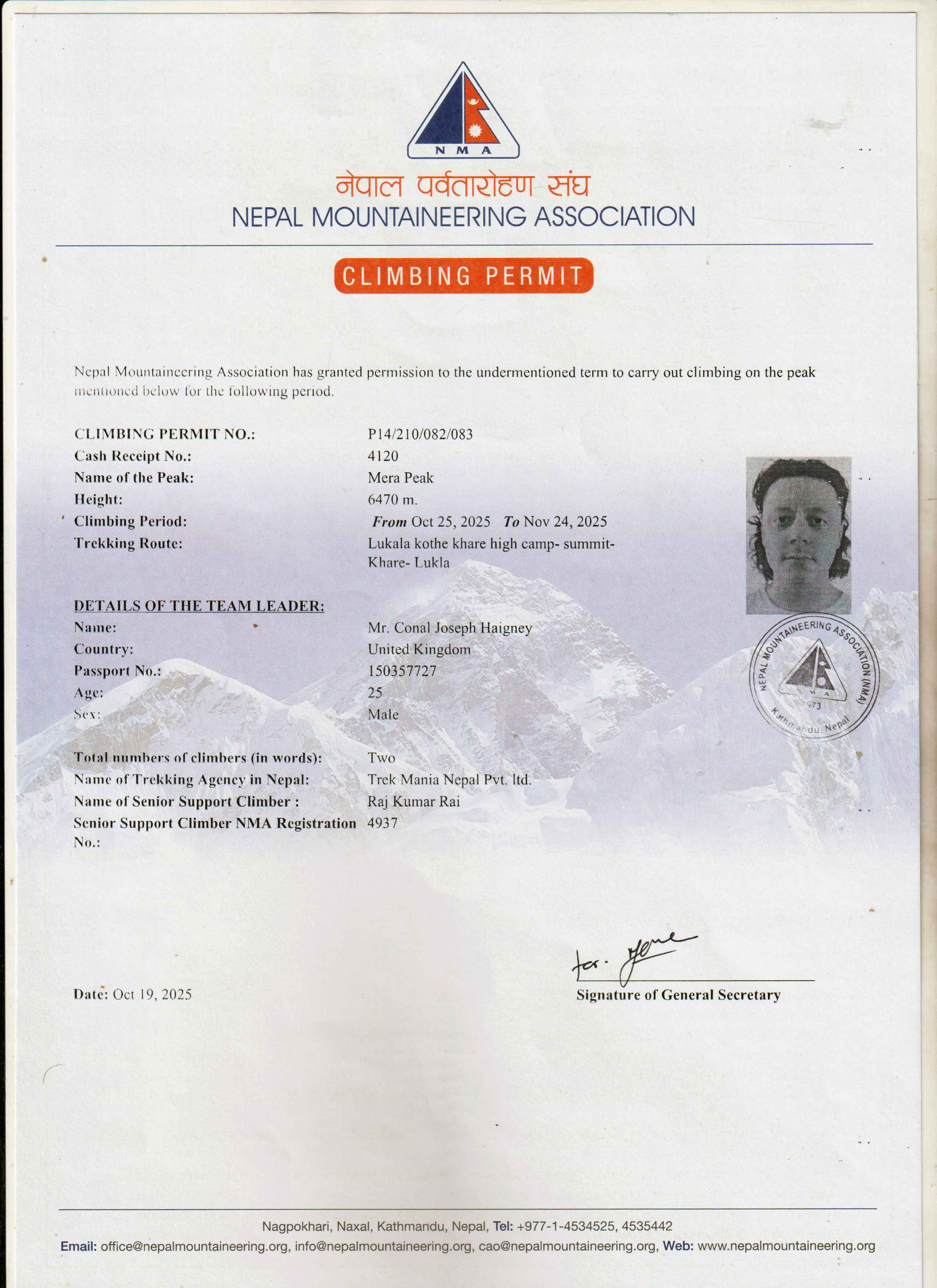
Climbing Mera Peak requires a few essential permits that help support conservation and local communities. The Mera Peak Climbing Permit is issued by the Nepal Mountaineering Association (NMA) and the cost varies by season—USD 350 in spring, USD 175 in autumn, and USD 175 in winter and summer. Additionally, climbers need the Makalu-Barun National Park Entry Permit and the Khumbu Pasang Lhamu Rural Municipality Entry Permit. These permits can be arranged in Kathmandu before the trek begins and are typically included in most organized expedition packages. Carrying valid permits at all times is mandatory and helps ensure a smooth, legal, and responsible climbing experience.
Highlights
- Breathtaking views of Mount Everest, Lhotse, Makalu, Cho Oyu, and Kanchenjunga.
- Diverse terrain, from lush forests to high alpine regions, including glacier crossings.
- Cultural interactions with Sherpa and local communities along the way.
- Remote and less-crowded wilderness compared to other trekking peaks.
- Spectacular sunset and sunrise views from the summit.
Cost Details
- Airport pickup and drop
- Two-night Deluxe hotel in Kathmandu
- Flight Lukla - Kathmandu
- Mera Peak Climbing Permit.
- Included Garbage disposal charge.
- Sagarmatha National Park Entry Permit.
- Khumbu Pasang Lhamu Rural Municipality Entry Permit
- One climbing guide (Sherpa) among two members.
- All Ground transport as per the itinerary.
- All standard Meals (Breakfast, Lunch, and Dinner) throughout the trek and climb
- Breakfast in Kathmandu.
- Accommodation in a lodge during the trek and basic camping arrangements during climbing.
- A porter for every two passengers (please make your bag 15 kg and around)
- Insurance for every staff member
- Mera Peak Climbing Map
- Emergency Helicopter rescue arrangement if in case (pay by your travel insurance) in the worst case only.
- Sleeping bag down jackets, if you do not have your own, to be returned after the trip.
- First Aid Box carried by the porter.
Seasonal Fruits throughout the trek - Medical supplies, first aid kit box, including an Oximeter and pulse meter checker.
- All other government taxes and expenses
- Personal clothing, gear, and climbing equipment
- Personal accident insurance, emergency evacuation cost, oxygen, and medical box.
- Alcoholic beverage, laundry, and tips.
- Extra night Hotel accommodation and sightseeing tour in Kathmandu (available as per your choice)
Dates & Pricing
Trip Start and End Point
Kathmandu / Kathmandu
| DATES | STATUS | PRICE | SPACE LEFT | ||||
|---|---|---|---|---|---|---|---|
|
Start date: 25-Jan, 2026
End date: 09-Feb, 2026 |
Guaranteed | USD 2550 |
2
|
Book Now | |||
|
Start date: 30-Jan, 2026
End date: 14-Feb, 2026 |
Guaranteed | USD 2550 |
3
|
Book Now | |||
|
Start date: 07-Mar, 2026
End date: 22-Mar, 2026 |
Guaranteed | USD 2550 |
3
|
Book Now | |||
|
Start date: 10-Mar, 2026
End date: 25-Mar, 2026 |
Guaranteed | USD 2550 |
5
|
Book Now | |||
|
Start date: 20-Mar, 2026
End date: 04-Apr, 2026 |
Confirmed | USD 2550 |
6
|
Book Now | |||
|
Start date: 31-Mar, 2026
End date: 15-Apr, 2026 |
Confirmed | USD 2550 |
4
|
Book Now | |||
|
Start date: 05-Apr, 2026
End date: 20-Apr, 2026 |
Guaranteed | USD 2550 |
3
|
Book Now | |||
|
Start date: 15-Apr, 2026
End date: 30-Apr, 2026 |
Confirmed | USD 2550 |
6
|
Book Now | |||
|
Start date: 24-Apr, 2026
End date: 09-May, 2026 |
Guaranteed | USD 2550 |
2
|
Book Now | |||
|
Start date: 02-May, 2026
End date: 17-May, 2026 |
Guaranteed | USD 2550 |
3
|
Book Now | |||
Equipment List
Checklist for Mera Peak Climbing in Nepal
For Head
· Balaclava that covers your ears
· Headlamp with extra batteries and bulbs
· Bandana or headscarf, very useful for dusty conditions
· Beanie
· Wide brimmed sunhat
· Neck gaiter or warmer
· Snow goggles and Sunglasses with UV protection (carry an extra pair in case you lose or break it)
· Prescription sunglasses (if required)
For Upper Body
· T-shirt (moisture absorbing and breathable)
· The thermal base layer of merino wool
· Fleece wind-stopper jacket or pullover
· Waterproof (preferably breathable fabric)
· Long sleeve shirt (moisture absorbing and breathable)
· Shell jacket
· Down Vest
· Expedition weight insulated down jacket with hood (not required for all trekking peaks )
· Gore-Tex jacket with hood, waterproof and breathable
For Hands
· A pair of lightweight poly-liner gloves or lightweight wool or fleece gloves
· Summit Mittens
(warm insulated gloves with safety straps)
For Lower Body
· Lightweight thermal leggings of merino wool
· Trekking trousers (waterproof, breathable fabric)
· Hardshell trousers
· Non-cotton underwear briefs
· Hiking shorts
· Synthetic insulated pants
For Feet
· Crampons
· Lightweight inner socks, heavy poly or wool socks and cotton socks
· Running shoes and rubber sandals/flip-flops
· Double insulated climbing boots
· Good quality hiking boots
(sturdy soles, water resistant, ankle support, “broken-in”)
· Gaiters
For Sleeping Purpose
· Sleeping Bag ( a 5 season sleeping bag, suitable for temperatures for as low as -40°C)
· Foam pad
· Fleece sleeping bag liner
· Therm-a-Rest sleeping pad (NeoAir XTherm) which offers insulation and warmth in sub-freezing temperatures
· Pillowcase
Personal Climbing Gears
· Ice axe
· Crampons
· Ascender/Jhumar
· Prusik rope
· Helmet
· Harness
· Tape slings (2)
· Screwgate karabiners (2 locks, 2 unlock)
· Descender/eight figure
· Plastic mountaineering boots
Group Climbing Gears
· Snow bar
· Rope
· Ice hammer
· Ice screw
Baggages
· Rucksack and Travel Bags
· A small daypack/backpack(30-40L) for carrying your valuables should have good shoulder padding.
· Large duffel bag (80-100L)
· Small padlocks for duffel-kit bags
· Waterproof covers
Medical
· Small, personal first-aid kit (simple and light)
· Paracetamol
· Cough and/or cold medicine
· Anti-altitude sickness pills - Diamox or Acetylzolamide
· Stomach antibiotic - Ciprofloxacin, etc. Do not bring sleeping pills as they are a respiratory depressant.
· Aspirin, first-aid tape, and plasters (Band-Aids)
· Skin-blister repair kit
· Anti-diarrhoea pills
· Throat lozenges
· Water purification tablets or a water filter
· Earplugs
· Lip guard
· Eye drops
· Extra pair of prescription glasses, contact lens supplies
· Sunscreen
Practical Items
· Alarm clock/watch
· Camera with extra SD cards and batteries
· Large Ziploc bags
· 2 water bottles (1 liter each)
· Small roll of repair tape, sewing-repair kit
· Binoculars (optional)
· 4 large, waterproof, disposable rubbish sacks
· Socket adapter Type C (with circular pins)
· Cigarette lighter / small box of matches
· Compass or GPS(optional)
· Lightweight steel thermal bottle
· Small folding or Swiss knife
· Trekking poles(foldable)
Toiletries
· Small sachets of shampoo
· Deodorants
· Nail clippers
· Face and body moisturizer
· Female hygiene products
· Small mirror
· Medium-sized quick-drying towel
· Toothbrush/paste (preferably biodegradable)
· Multipurpose soap (preferably biodegradable)
Personal Hygiene
· Anti-bacterial handwash
· Hand sanitizer
· Pee Bottle (1 litre, leak-proof, wide mouth)
· Pee funnel (for female)
· Wet wipes (baby wipes)
· Tissue /toilet roll
Extras/Luxuries
· Reading book
· Trail map/guide book
· Journal and pen
· iPod
· Playing cards (to help you pass the time at teahouses and/or camps)
· A modest swimsuit
· Binoculars (optional)
FAQs
The best months are pre-monsoon (March to May) and post-monsoon (September to November). During these periods, the weather is stable, skies are clear, and the views of Everest, Lhotse, Makalu, and other peaks are spectacular.
Mera Peak is considered a challenging trekking peak rather than a technical climb. It requires good fitness, stamina, and some basic mountaineering skills such as using crampons and an ice axe.
No prior experience is strictly required, but previous trekking experience above 4,000 meters is highly recommended. Our expert guides will provide all necessary training and support.
The summit of Mera Peak is 6,476 meters (21,247 ft) above sea level. Acclimatization days are included to reduce the risk of altitude sickness.
A good level of fitness and stamina is necessary. Participants should be able to trek 5–7 hours daily at high altitudes and handle snow and ice conditions. Regular cardiovascular exercise and hiking prior to the trip is recommended.
Lodges and tea houses are standard along the route. They offer basic facilities, including twin-sharing rooms, hot meals, and shared bathrooms. On the high camp during climbing, tents may be used.
Mobile networks are limited along the route. Most tea houses have Wi-Fi at an extra cost, but signal may be unreliable.
Risks include altitude sickness, cold weather, snow/ice hazards, and fatigue. Following guide instructions, acclimatization days, and proper preparation will minimize risks.
Yes, trekking and mountaineering insurance covering high-altitude trekking, rescue, and helicopter evacuation is mandatory.


